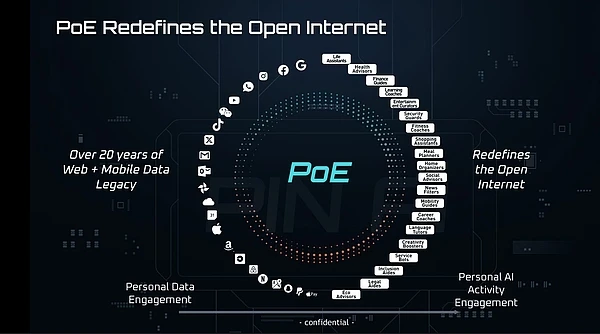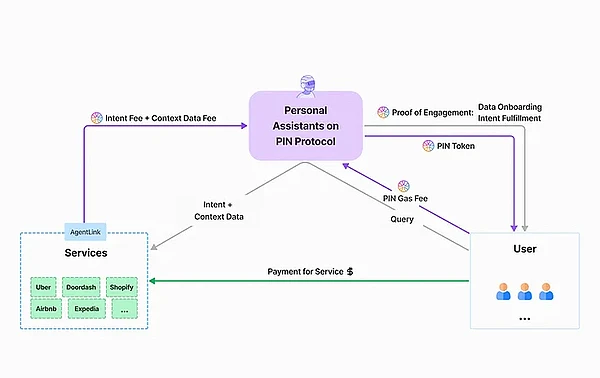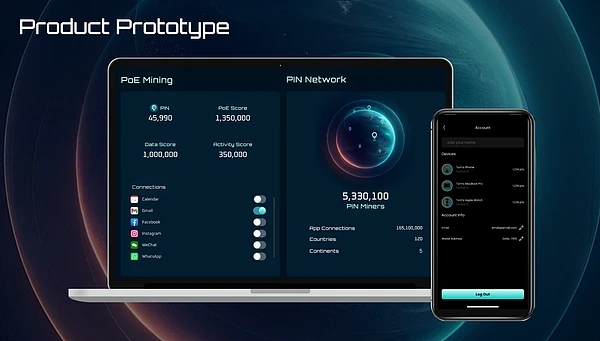I am honored to have completed this research under the guidance of Meteorite Labs, based on the experience and communication of hundreds of Web2 AI applications.
PIN AI is a selected project for the a16z Crypto Startup Accelerator Fall Program, with a seed round financing of 10 million USD. Notable VCs include a16z Crypto, Stanford Blockchain Accelerator, Hack VC, and Foresight Ventures. Angel investors include Illia Polosukhin, founder of NEAR Protocol, Scott Moore, co-founder of Gitcoin, Lily Liu, Chair of the Solana Foundation, Evan Cheng, CEO of SUI/Mysten Labs, and DCBuilder, research engineer at Worldcoin.
I just finished reading an article co-authored by the three co-founders of PIN AI and found it to be the most intriguing Web3 AI project recently, aside from Sahara. The application scenarios are very interesting. (Article link: https://www.pinai.io/post/pin-ai-the-open-platform-for-personal-ai)
PIN AI is an open AI network where developers can build useful AI applications. "Useful AI Applications" is the focus of its product. It is somewhat similar to AI agents like MultiOn and Jace.ai in Web2, dedicated to providing users with useful applications for daily life, such as online shopping, travel planning, and investment planning.

Let me briefly introduce Jace.ai. It is an AI agent that can independently perform tasks in the browser, based on LLM and its proprietary model AWA-1 (Autonomous Web Agent-1), which supports AI in executing operations on web pages.
Jace's greatest ability is to autonomously plan tasks and perform operations in the browser on behalf of the user.
To understand the application scenario, if I tell Jace, "I am planning to travel to Beijing for a week on September 20th with a budget of 5000 RMB, help me plan it," Jace will automatically plan a trip, including the places to visit, the hotel to stay in, and the food to eat. If I agree to this travel plan, it will help me book all the attractions, find the best value hotel on Meituan, and place the order. I only need to enter personal information and click to pay.
In fact, what PIN AI aims to do is very similar. The biggest difference from generative AI is that these AI projects mainly focus on users' daily lives rather than work.
I. Deconstructing the Design Concept of PIN AI
In simple terms, PIN AI = AI + DePIN
PIN AI Network consists of two types of AI:
Personal AI: A personalized AI agent that can adapt to user preferences in real time. It serves as the connection point between users and agent services, somewhat like a coordinator. Users can download it to their mobile phones or computer devices for use.
Agentic Services: AI agents built on-chain for some top Web2 platforms, capable of executing tasks on these platforms, with the process and completion status recorded on the blockchain.
The official also mentioned External AI, which may support interaction with other LLM or Web2 AI agents in the future.
Core architecture of PIN AI:
PIN Protocol, a type of DePIN distributed data storage network, where anyone can connect their devices to the network and share data. It integrates BERT-based models to anonymize data at various stages of processing user data, ensuring privacy and compliance with data protection regulations.
Personal AI is built on top of this network, providing personalized data for Personal AI on one hand, and the most relevant data for agent services on the other.
PIN Protocol is built with three components:
1. Private Storage and Computing Layer: Distribute storage of data, securely store user-shared device data (including photos, videos, etc.), and make the most relevant data available for Personal AI and agent services at any time. Users can connect their devices to the network, provide device data, and receive native token $PIN rewards.
2. Data Connector: Uses zk technology to track and verify user data connected to the network. I think it's similar to the nodes of the PIN network. Node operators need to stake $PIN tokens for verification, and some token holders can stake tokens to the nodes, both of which can receive token staking rewards.
3. Agent Link: Aims to match Personal AI with agent services. It consists of an agent registry and transaction mechanism, where the former is used to track performance metrics, and the latter "thinks" about how to match Personal AI with agent services (based on the cost, performance, and completion quality of each agent service).
User usage pattern/business logic:
When users make a specific request, PIN AI will follow these steps:
Step 1: Personal AI - Collect user requests
Users make requests to Personal AI, which then forwards the requests to PIN Protocol.
Step 2: PIN Protocol - Prepare for task execution
Break down user intent into specific steps, find the most suitable and cost-effective agent services, retrieve the most relevant data, and provide it to the agent services. (If it involves multiple Web2 platforms, the intent needs to be split among different agent services.)
Step 3: Agent Services - Execute specific steps
Step 4: PIN Protocol - Provide feedback to the user
After all, most daily life needs involve financial transactions. In PIN AI, the flow of funds should be:
Users pay Gas fees to PIN Protocol (I guess it might be to activate this intent transaction). Since PIN Protocol first breaks down the user's intent, then indexes and sends the most relevant data to the agent services, after the agent services complete the task, they will return part of the service fee as a tip to PIN Protocol.
So, both PIN Protocol and agent services can take a cut from the service fee paid by users.

For example:
Users can download Personal AI to their computers or phones, make requests to Personal AI, such as "buy the cheapest GTX 3080 graphics card on Amazon," and pay fees (purchase fee + service fee + PIN Protocol Gas fee).
Personal AI will convey this request to PIN Protocol.
After understanding and breaking down user intent, PIN Protocol will break down the user's intent into specific task steps and send them to the agent services along with the most relevant data. There may be dozens of specialized agent services for Amazon shopping, so PIN Protocol needs to comprehensively consider their cost, performance, and past completion records to select the most suitable one.
The agent service will find the best value GTX 3080 graphics card on Amazon and place the order. After completion, the intent breakdown fee and data call fee will be paid to PIN Protocol. PIN Protocol and Personal AI will provide feedback to the user and send PIN tokens as a reward to the user.
Network Participants
Personal AI Users: Install Personal AI on a computer or phone, connect personal data to PIN Protocol, and receive PIN token rewards.

Value Flow Users: Similar to the usage pattern mentioned above, users who engage in valuable transactions will also receive PIN token rewards.
PIN Protocol Nodes: Track and verify user data connected to the network. Operators need to stake, and token holders can stake tokens to the nodes, both of which can receive staking rewards.
Agent Services: Developers can earn service fees.
II. Core Development Team
Davide Crapis - Co-founder
Background in blockchain protocol design, with some AI background.
Formerly a senior data scientist at Lyft, where he designed and implemented incentive allocation algorithms, distributing xx dollars in growth incentives to passengers and drivers annually. After resigning, he spent some time as an independent researcher studying incentive schemes and token distribution. Before founding PIN AI, he was a research scientist in the "robust incentives" direction at the Ethereum Foundation.
He has developed a machine learning model for "consumer sensitivity to investment/credit product rates" and has also served as a researcher and mentor in machine learning at Columbia Business School for four years. He has also been involved in the Web2 developer community "South Park," exploring the intersection of large language models and blockchain.
Ben Wu - Co-founder
Operational background, likely providing strategic direction and AI product ideas.
MIT graduate and Y Combinator alumnus. Before founding PIN AI, he served as Director of Database and Operations at Yahoo's Strategic Data Solutions department, responsible for the operation and management of large-scale data projects.
Bill Sun - Co-founder, Chief Scientist
Background in quantitative trading and AI.
Ph.D. in Mathematics from Stanford University, formerly conducted AI research at Google DeepMind. He worked as an AI/quantitative trading stock investment manager at a Wall Street asset management company. He founded the AI research organization AI+Club and the AI technology community AGI House. An angel investor in a16z scout fund. He is also the founder of Generative Alpha, providing enterprise-level AI solutions.
III. Reflection and Conclusion
The first industrial revolution freed our hands with machinery;
The second industrial revolution broke the boundaries of day and night with electricity;
The third industrial revolution integrated the boundaries between the virtual and the real with the internet.
The emergence of AI is widely regarded as a sign of the fourth industrial revolution, and AI agents are the tickets on this exploratory journey, allowing each of us to board the giant ship heading towards the future of "human-machine interaction."
In the past few decades, a large amount of activity has occurred on the internet every day, generating massive amounts of data. However, users have not had ownership of this data.
With the recent release of the iPhone16, Apple Intelligence has been introduced, but PIN AI has the opportunity to establish a more open AI agent ecosystem than Apple Intelligence.
In this ecosystem, developers can earn rewards by developing innovative Web2 platform agent services, which will lead to a wave of innovation with increasingly high-performance and high-quality AI agents.
And billions of mobile phone users can not only use personalized Personal AI but also share device data to earn rewards.
User data supports the entire PIN AI ecosystem, which is the power of users and the starting point of Web3 - decentralization and ownership.
I hope to see the landing of the PIN AI network as soon as possible and whether the incentive mechanism can effectively function, attracting a large army of open-source contributors and creating an even larger wave of innovation. The testnet may be launched in October, and the mainnet and TGE may be launched in January next year, which is worth looking forward to.
免责声明:本文章仅代表作者个人观点,不代表本平台的立场和观点。本文章仅供信息分享,不构成对任何人的任何投资建议。用户与作者之间的任何争议,与本平台无关。如网页中刊载的文章或图片涉及侵权,请提供相关的权利证明和身份证明发送邮件到support@aicoin.com,本平台相关工作人员将会进行核查。




